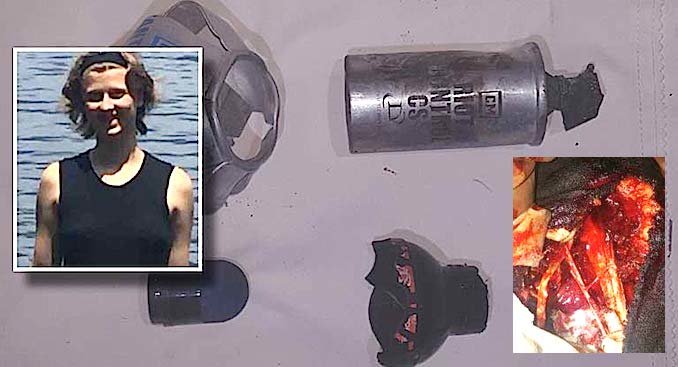
One young water protector, Sophia Walinksy, now faces the possibility of amputation, after one such device exploded point blank on her arm, shredding it down to the bone. A 13-year-old girl was shot in the face with a rubber bullet, and two tribal elders suffered cardiac arrest during the brutal police offensive and had to be resuscitated on scene.
Amid a complete blackout by the negligent corporate media, police from some 20 agencies and five states, led by the Morton County Sheriff's Department, unleashed an over six-hour assault on water protectors, launching tear gas and concussion grenades, firing rubber bullets, and — perhaps most perilously and insultingly — soaking the captive crowd of around 400 with icy cold water in frigid temperatures.
Walinsky, according to witnesses and a statement via her father, Wayne, had been delivering much-needed water to the group on the Highway 1806 Backwater Bridge when what is believed to be a concussion grenade exploded on her arm, ripping through flesh and muscle, leaving bone exposed.
Beginning early Monday morning, Unicorn Riot, which had been reporting from the bridge overnight, returned to the scene to gather evidence and discovered spent munitions shells with markings from Safariland — including fragments of Stinger grenades.
Anonymous DeadSec, under the Twitter account @AzureDeadSec, took responsibility for taking down the Safariland site, tweeting, with a link to prove the downed site:
@TMTalways @WorldAnonLegion @UR_Ninja @NoDAPL TANGO DOWN! Stop selling weapons being used against Water Protectors. https://t.co/F2SltHeg0g pic.twitter.com/O5Riq4DFb8 — DeadSec (@AzureDeadSec) November 22, 2016
#Breaking - https://t.co/mjxwf1pmTp, site of @SafarilandGroup who made "less lethal" munitions used on #NoDAPL, taken offline by Anonymous pic.twitter.com/vHXH97NgH8 — Unicorn Riot (@UR_Ninja) November 22, 2016Morton County Sheriff's Department spokeswoman Maxine Herr hubristically claimed in the Los Angeles Times that Walinsky could not possibly have been hit by anything from police, and must have been rigging a makeshift explosive device of her own to receive such an injury. "It wasn't from our law enforcement, because we didn't deploy anything that should have caused that type of damage to her arm," Herr boldly contended. "We're not sure how her injury was sustained."
Thanks to Unicorn Riot's careful inspection of the scene, however, the sheriff's department appears to be lying through its teeth.
Prior to the DeadSec takedown of the Safariland site, the description of Stinger grenades — identical to the pieces found at the site of the police assault on water protectors — indeed sound as if they would readily cause the horrific injury Walinsky endured:
"The Stinger OC Grenade is a maximum effect device that delivers four stimuli for psychological and physiological effects: rubber pellets, light, sound, and OC. The Stinger Grenade is most widely used as a crowd management tool by Law Enforcement and Corrections. The Stinger Grenade has an initial 1.5 second delay that initiates fuze assembly separation, followed by another .5 second delay before the blast which is sufficient to project the rubber balls and chemical agent in a 50 foot radius."If such a grenade landed on the young water protector's arm, that 50-foot blast radius would be concentrated in a reduced space, and could obviously cause severe injury and disfigurement.
Piece of Stinger grenade recovered from Hwy 1806 last night appears to match this @SafarilandGroup product- https://t.co/FnWoyrjksT #NoDAPL pic.twitter.com/5fVnQw4RJe — Unicorn Riot (@UR_Ninja) November 22, 2016Safariland's CS gas (tear gas) canisters also littered the area where police launched the altogether disproportionate assault on Standing Rock Sioux and other water protectors, and — again prior to the site being taken offline by Anonymous — described symptoms such as induced panic, and possible cardiac arrest.
Chemical/"less lethal" munitions fired at #NoDAPL water protectors by Morton County Sheriff and supporting agencies Sun night/Monday morning pic.twitter.com/Zh2lrHTIsn — Unicorn Riot (@UR_Ninja) November 22, 2016Such weapons, though they might be employed by police for crowd control under the broad characterization of less-than lethal, nonetheless can and do maim and even kill.
The Morton County Sheriff's Department noted one officer received a head wound from a projectile launched by someone in the group of water protectors. However, police at Backwater Bridge launched the offensive from behind body armor, helmets, and riot shields, and were backed by blast-proof military vehicles — water protectors, in marked contrast, had nothing to shield themselves from the onslaught of chemical weapons, projectiles, and lower-intensity water cannons.
Those present in the group reported being choked with tear gas and then inundated with water, freezing clothing to skin almost immediately in the 23° weather. Scores suffered hypothermia, at least 20 water protectors had to be hospitalized, some in serious condition — and more than 165 people reported injuries of varying degrees.
Considering Safariland's insidious weapons directly contributed to the suffering — and, in one case, permanent disfigurement, if not amputation — of peaceful water protectors whose only goal is to preserve clean drinking water for this and future generations, Anonymous' takedown of the site makes sense.
Sophia Walinsky is currently enduring multiple surgeries at the Minnesota hospital where she was airlifted in an attempt to preserve her arm, but it still isn't clear whether that will be possible. A GoFundMe campaign to assist her with medical expenses can be found here — if you are unable to contribute, please consider sharing the campaign.
Standing Rock Sioux water protectors face even tougher times ahead in their battle to halt construction of the Dakota Access Pipeline, with temperatures this winter expected to be even lower than the frosty average. There are many ways you can help them this winter, a list of suggested items to donate and further information can be found here. You can also voice your concerns about police treatment of water protectors by contacting those responsible for the pipeline, and a suggested list can be found here.




Comment: